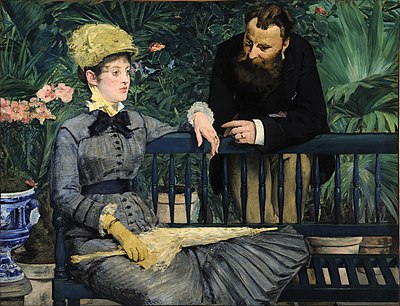Talk:In the Conservatory
| This article is rated Start-class on Wikipedia's content assessment scale. It is of interest to the following WikiProjects: | ||||||||||||||||||
| ||||||||||||||||||
Hello! This is a note to let the editors of this article know that File:In the Conservatory - edited.jpg will be appearing as picture of the day on July 11, 2014. You can view and edit the POTD blurb at Template:POTD/2014-07-11. If this article needs any attention or maintenance, it would be preferable if that could be done before its appearance on the Main Page. Thanks! — Crisco 1492 (talk) 02:59, 27 June 2014 (UTC)
Comment on caption
[edit]- " the couple appear detached from both each other and the conservatory around them."
- Not the case. The woman appears detached. She is deep in thought. Her husband is anything but detached; he is right there in the present. He is leaning towards her, looking at her, and raising his index finger as if to touch her hand. In other words, he is trying to break her reverie. What we have here is interaction.
- In describing an image, it is necessary to really look.
- The main page caption is based on the article. I'd have really appreciated if this had been raised a week or two ago (that's the reason why images are scheduled so far ahead). — Crisco 1492 (talk) 08:31, 11 July 2014 (UTC)
Posture In the text of the article, it mentions the woman's "upright posture". That posture is indicative of the constraint placed on the figure by a tight corset that goes all the way from the top of the hips to the armpits. The only points of flexibility are the neck and the hip-joints. She can sit, bend at the hip-joints and lean back at a diagonal, but stooping, slumping and twisting are impossible. It is ghastly to thing of how many generations of women suffered this constraint. (Actually, I think she has morning sickness and is about to throw up behind the aspidistra.)
The diagonal pleats are from the back of the skirt, below the bustle. It would probably be correct to describe them as part of the bustle, which implies the whole gathering of cloth at the back of the garment, rather than just the padding or frame over which the back fullness was suspended.


